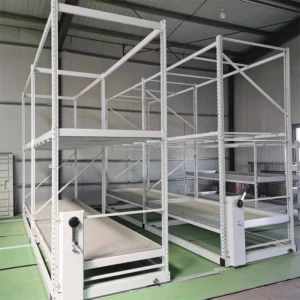The Mobile Grow Rack design can accommodate shading and cooling systems in several ways to create optimal growing conditions for plants. Here are some methods:
- Shading Material Integration: The Mobile Grow Rack can be designed with provisions for integrating shading materials such as shade cloth or shade netting. Retractable or adjustable shade systems can be installed on the rack structure to provide customizable shading levels based on the specific light requirements of different crops or environmental conditions.
- Roll-Up Side Curtains: The Mobile Grow Rack can feature roll-up side curtains that allow for natural ventilation and airflow while providing shading during peak sunlight hours. These curtains can be made from shade cloth or mesh fabric and can be manually or automatically operated to adjust shading levels as needed.
- Misting Systems: Misting systems can be integrated into the Mobile Grow Rack design to provide evaporative cooling and humidity control within the growing environment. Fine misting nozzles can be strategically positioned along the rack structure to distribute water vapor evenly and lower ambient temperatures, reducing heat stress on plants during hot weather conditions.
- Fan and Ventilation Systems: The Mobile Grow Rack can incorporate fan and ventilation systems to promote air circulation and heat dissipation within the growing area. Exhaust fans or circulation fans can be installed on the rack structure to remove hot air and draw in cooler air from outside, creating a more comfortable and stable microclimate for plants.
- Cooling Pads or Evaporative Coolers: Cooling pads or evaporative coolers can be integrated into the Mobile Grow Rack design to provide additional cooling capacity during periods of high temperatures. China Mobile Grow Rack supplier These systems use water evaporation to lower the temperature of incoming air, effectively reducing heat buildup and maintaining optimal growing conditions inside the greenhouse.
- Thermal Insulation: The Mobile Grow Rack can be constructed with thermal insulation materials to minimize heat transfer and reduce thermal load on plants. Insulating panels or coatings can be applied to the rack structure to create a thermal barrier that helps stabilize temperatures and prevents overheating during hot weather conditions.
- Temperature and Humidity Sensors: Integrated temperature and humidity sensors can be installed throughout the Mobile Grow Rack to monitor environmental conditions and ensure precise control of shading and cooling systems. Automated control systems can adjust shading levels, activate misting or ventilation systems, and optimize cooling strategies based on real-time data to maintain ideal growing conditions for plants.
By incorporating these features and systems into the Mobile Grow Rack design, growers can effectively manage shading and cooling to create a comfortable and productive growing environment for plants, regardless of external weather conditions or seasonal variations.
